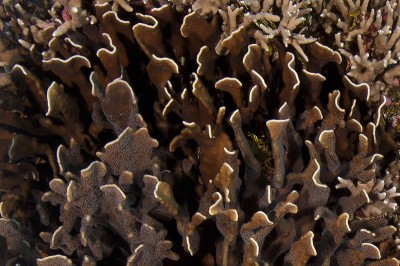Expedition Log: Palau – Day 10
While I perform my task of taking coral photo transects during our survey dives, I get a close look at the reef (one square meter at a time). One side effect of focusing my attention toward the bottom, from a distance of about a meter away, is that I tend not to see the sharks, bumphead parrotfish, dogtooth tunas, and other fishes that pass silently behind me. The upside of taking several thousand photos of the reef per mission is that I am slowly starting to learn the diversity of Pacific corals. In the Tropical Western Atlantic, where I usually do reef surveys, I am very familiar with the sixty or so species of reef building corals found there. Here in the Pacific, there is an order of magnitude more corals, and so, the learning curve is much steeper. Luckily, many of the reefs we dive on are dominated by a small number of coral genera (such as Acropora, Porites, Fungia, Pocillopora, Seriatopora, Pavona, Merulina, Pachyseris), so it is possible to understand much of what I see—at least at the genus level.
On a morning dive on a site called Santa Maria Corner, off Angaur Island in the extreme southwestern tip of Palau, I noticed something novel while doing my photo transects at 15 meters depth. My transect ran through a patch of an interesting coral species with flat upright blades. It appeared to me to resemble a chocolate brown version of one of the fire coral species (Millepora complanata) that I’m familiar with back in my part of the world. I made a mental note to ask about this species after the dive, as it was new to me. A little while later in the dive, as I was finishing my last transect up at 5 meters, I encountered a second “mystery” species that was an odd bluish-green color and was boulder shaped with a knobby texture. Imagine my surprise when I later learned that these two species that were new to me, turned out to be a single species—and an interesting one at that: Blue Coral (Heliopora coerulea).


The dark brown thin bladed form with tiny whitish polyps extended on some of the blades and the lumpy greenish-blue form both turn out to be the same species—Heliopora coerulea.
(Click-thru on images for greater detail.)
Heliopora coerulea is the only species in the family Helioporidae which is the only member of the order Helioporacea. This coral stands alone, not only taxonomically, but also with some unusual properties that add to its unique nature. Though Blue Coral is actually a member of the octocorallian soft corals (subclass Alcyonaria), it is the only octocoral known to produce a massive skeleton. Like the reef building (scleractinian) hard corals, its skeleton is formed of aragonite, a form of calcium carbonate. Its common name stems from the coral’s ability to extract iron from the surrounding seawater, which it forms into a blue salt that is incorporated into its skeleton, turning it a sky blue color. The individual coral polyps live in fine tubes within the skeleton and are interconnected by a thin layer of tissue covering the outside of the skeleton.


This Blue Coral colony with its small fuzzy white polyps extended shows only faint hints at the tips of the underlying blue skeleton. A close-up view of the broken end of a Blue Coral branch shows the blue coloration of the skeleton and some of the thin tubes where the polyps are found.
(Click-thru on images for greater detail.)
To add to its pedigree, Blue Coral is also called a living fossil, as it has been found in deposits dating back to the Middle to Upper Cretaceous (roughly 100 million years ago). At one time, the family Helioporidae was a dominant coral throughout much of the world’s oceans, but today this coral only survives in a narrow band of tropical waters in the Indo-Western Pacific, generally between 25 degrees north and 25 degrees south. It is relatively uncommon outside of Tuvalu and Kiribati.


Some of the wide variety in color and form found in Blue Coral (Heliopora coerulea).
(Click-thru on images for greater detail.)
The beauty of the coral’s blue skeleton has made it popular with curio collectors. This coral is gathered for its blue aragonite base by collectors and those who make and sell jewelry. Due to its limited distribution and the potential for overexploitation, Heliopora coerulea is on the IUCN Red List for Endangered Species as Vulnerable (VU) and it is listed on Appendix II of the Convention on the Trade in Endangered Species of Wildlife (CITES), which means that it can be exported only under permit, if the trade is deemed sustainable.
Photos: 1-6 Ken Marks
One Comment on “Blue, You Say?”
Asaad
how has the blue coral adapted over time ?